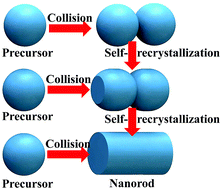Oriented attachment (OA) growth has been a promising method for the synthesis of one dimensional (1D) anisotropic nanocrystals (NCs). An unresolved fundamental issue is to understand the growth mechanism at the initial stage of an OA nanorod (NR) growth. In this report, a collision–recrystallization model is proposed to investigate the initial OA growth of NRs. The repulsive electrical double layer (EDL) interaction and the attractive van der Waals (vdW) interaction at the initial OA stage are derived by the accurate surface element integration (SEI) technique and the classical Hamaker equation, respectively. Our results show that the self-recrystallization of nanochains increases the collision activation energy of NPs dramatically as their surface potentials and Hamaker constants increase. Under a specific electrolyte concentration, the collision activation energy reaches the maximum, indicating that the growth rate of OA can be controlled by adjusting the electrolyte concentration.
